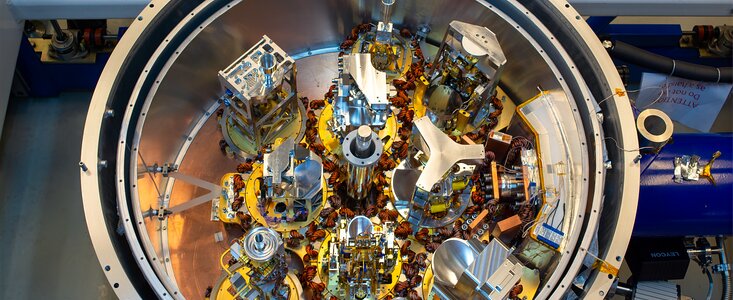Announcement
New ALMA receivers that will probe our cosmic origins successfully tested
14 August 2023
An international team of astronomers and engineers at the Atacama Large Millimeter/submillimeter Array (ALMA), in which ESO is a partner, have made the first measurements using new receivers installed on multiple ALMA antennas. The receivers allow ALMA to observe within the final frequency range — with wavelengths between 2.6 to 4.5 millimetres (67-116 GHz) — for which it was designed. This so-called “Band 2” opens a new window into our cosmic origins, allowing measurements that reveal how distant stars and galaxies form, all the way down to the origins of planets and the building blocks of life.
ALMA, located on the Chajnantor Plateau in Chile, consists of a total of 66 antennas, each equipped with an arsenal of highly sensitive receivers. Each receiver type observes within a particular band, or range of wavelengths in the submillimetre/millimetre region of the electromagnetic spectrum. In total these bands cover a window from 0.3 to 8.6 millimetres (950 to 35 GHz; Bands 10 to 1, respectively). Band 2 opens a completely new window from 67-84 GHz, while expanding the bandwidth available in the 84-116 GHz frequency range, which is also covered by band 3.
The first Band 2 pre-production receiver was successfully installed and tested on an ALMA antenna earlier this year. Now, a second and third Band 2 pre-production receiver have been installed on two other ALMA antennas, enabling true interferometry: measuring the fringe pattern that results from the correlation of multiple signals from a bright astronomical object. This “first fringes” milestone means astronomers have been able to combine the signals from multiple antennas for the first time in Band 2. As further ALMA antennas are upgraded with Band 2 receivers, the amount of detail and level of sensitivity will improve, allowing for ever more precise observations of our Universe.
ALMA Band 2 will allow important measurements of the cold interstellar medium, the mixture of dust and molecular gas that exists in the space between stars and fuels star formation. As well as this, ALMA will be able to study the properties of dust and molecules in objects from planet-forming discs to far-away galaxies at a level of detail never achieved before.
Closer to home, the new receivers will enable observations of complex organic molecules in nearby galaxies, providing clues on how the conditions for life to begin are created. At the same time, Band 2 will be important for helping astronomers better understand how planets form by probing the carbon monoxide “snow line”, a region in planet-forming discs far away enough from the central stars for gas to condense.
The development of Band 2 was led by ESO and included partners at the National Astronomical Observatory of Japan (NAOJ), University of Chile, several European institutes and industry. Production of the first receiver cartridges was then carried out by a consortium comprising the Netherlands Research School for Astronomy (NOVA), the Advanced Receiver Development (GARD) group at the Onsala Space Observatory, Chalmers University, Sweden, and the Italian National Institute for Astrophysics (INAF), in collaboration with NAOJ.
Now, the team will work to optimise the performance of the pre-production receivers, and this will be followed by full production of the remaining receivers for installation on all 66 antennas, ushering in a new era of observations for ALMA. In concert with complementary ALMA upgrades planned for the 2030 time frame, the installation of Band 2 will enable an instantaneous bandwidth four times larger than what most current ALMA receivers can achieve, dramatically increasing its observation speed.
More Information
ALMA is a partnership of ESO (representing its member states), NSF (USA) and NINS (Japan), together with NRC (Canada), NSTC and ASIAA (Taiwan), and KASI (Republic of Korea), in cooperation with the Republic of Chile. The Joint ALMA Observatory is operated by ESO, AUI/NRAO and NAOJ.
Contacts
Bárbara Ferreira
ESO Media Manager
Garching bei München, Germany
Tel: +49 89 3200 6670
Email: press@eso.org
About the Announcement
| Id: | ann23013 |






